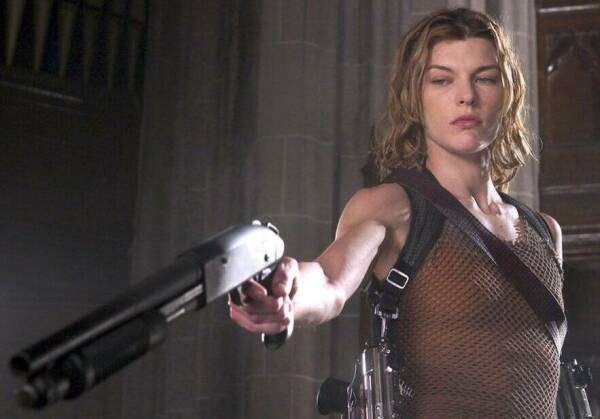 ★★★★
★★★★
“Apocalypse NOW…”
 The history of cinema has provoked many furious arguments as to which is better. Dracula or Frankenstein? Moore or Connery? Alien or Predator? And now we can add another to the list: tank-top or bustier? For we have not one, but two action heroines here, both finely-honed killing machines, with slightly different though similarly-slutty tastes in clothing. That really tells you all you need to know about this sequel, which never lets practical issues like plot – or costume – get in the way of the gratuitous violence.
The history of cinema has provoked many furious arguments as to which is better. Dracula or Frankenstein? Moore or Connery? Alien or Predator? And now we can add another to the list: tank-top or bustier? For we have not one, but two action heroines here, both finely-honed killing machines, with slightly different though similarly-slutty tastes in clothing. That really tells you all you need to know about this sequel, which never lets practical issues like plot – or costume – get in the way of the gratuitous violence.
Numerous reviews have complained about the lacklustre scripting, poor characterisation, etc to be found here. Hello! It’s based on a computer game! And a proper one, about shooting zombies, not wussy nonsense like finding jobs or raising children, fans of The Sims please note. Plus, it’s a sequel to boot, and if you expect sensitive drama from any film whose title contains the words “Evil” and “Apocalypse”, you simply need to get out more. It’s called expectation management, people.

 The tactic here was simple and clear. Keep all the good stuff from the original, e.g. Milla Jovovich, zombie dobermans, and throw a few new elements in, this time including some stuff which, unlike Jovovich’s character, Alice, actually has a significant connection to the game. Hence, you get Jill Valentine (Guillory), a special forces chick who, in most other movies, would be the heroine, but is here largely to show you how Alice v2.0 has been improved beyond human. It’s reminiscent of how Ripley, by Alien Resurrection, had partly been transformed into what she was fighting, and Alice is now faster, stronger and cooler than she was last time – which is something of an achievement in itself.
The tactic here was simple and clear. Keep all the good stuff from the original, e.g. Milla Jovovich, zombie dobermans, and throw a few new elements in, this time including some stuff which, unlike Jovovich’s character, Alice, actually has a significant connection to the game. Hence, you get Jill Valentine (Guillory), a special forces chick who, in most other movies, would be the heroine, but is here largely to show you how Alice v2.0 has been improved beyond human. It’s reminiscent of how Ripley, by Alien Resurrection, had partly been transformed into what she was fighting, and Alice is now faster, stronger and cooler than she was last time – which is something of an achievement in itself.
The story more or less picks up immediately after the events of the original, with the zombiefying T-virus now loose in Raccoon City – hence an almost infinite supply of the undead. The Umbrella Corporation quarantine the place, but the daughter of their top scientist is still inside. He tracks down the human survivors inside and tells them if they rescue his offspring, he’ll get them all out of the city before it’s turned into a mushroom cloud. But just to spice things up, the top Umbrella creation, Nemesis, is now also loose in the city, using it as a testing ground.
There are, I will admit, absolutely no surprises in the plot at all. When someone comes up to “rescue” a small child who is facing resolutely away from the camera, you know that little girl will inevitably turn out to be a zombie. But guess what? I really wouldn’t have it any other way. Much like Shakespeare(!), this kind of film isn’t about unexpected twists in the plot, it’s about the execution, and that’s where this film delivers solidly.
 Or at least, mostly solidly – let’s get the criticism out of the way first. Witt wants to stick the camera right in there, when what we want to do is fully appreciate the grace and athleticism of the heroines, not suffer from motion sickness. Also: hello, “R”-rating? Presumably this was for the language, topless undead hookers, and Milla’s scarily-large nipples (Chris pointed out they’re almost larger than her breasts), because it certainly wasn’t for the gore. These monsters were almost bloodless, even when shot through the head or exploded by hand-grenade – the latter would seem dangerous when you’re dealing with a highly-infectious, fluid-borne disease, but I’m quibbling here.
Or at least, mostly solidly – let’s get the criticism out of the way first. Witt wants to stick the camera right in there, when what we want to do is fully appreciate the grace and athleticism of the heroines, not suffer from motion sickness. Also: hello, “R”-rating? Presumably this was for the language, topless undead hookers, and Milla’s scarily-large nipples (Chris pointed out they’re almost larger than her breasts), because it certainly wasn’t for the gore. These monsters were almost bloodless, even when shot through the head or exploded by hand-grenade – the latter would seem dangerous when you’re dealing with a highly-infectious, fluid-borne disease, but I’m quibbling here.
Otherwise, the film takes the right pieces and puts them together in the right order, which is a good deal more than we’ve come to expect from any big-budget Hollywood action movie [Yes, I’m talking to you, Van Helsing and LXG]. The Nemesis monster is one creepy-looking dude, and Alice’s encounters with him are the stuff of nightmares. Another highlight is the return of the lickers, in a church through whose stained-glass windows Alice comes crashing on a motorbike, at the start of one very cool sequence. [Incidentally, to answer the “Why did she do that?” question raised by many reviewers, I assume she was attracted to the scene by the gunshots.]
 As mentioned, the undead attack canines are also back, and just as bad as before; this time, it’s mostly Valentine who has to deal with them, at least until the end, when Alice effortlessly one-ups her rival yet again. We briefly muttered “catfight!” under our breath, and it’d certainly have been fun to see Jill and Alice go toe-to-toe, but the outcome of that would be so predictable – Alice would win, without even breaking sweat – that its omission is understandable. The supporting characters do their job adequately; Mike Epps is the comic relief, something not really present in the first film, and manages the tricky task of doing the job without becoming annoying. Oded Fehr is somewhat irrelevant as a soldier also after the scientist’s daughter, while Sandrine Holt, playing journalist Terri Morales, is understandably overshadowed by Jill and Alice. On the Umbrella side…blah evil corporate drone, blah misunderstood scientist blah, blah. We don’t care – and nor should we.
As mentioned, the undead attack canines are also back, and just as bad as before; this time, it’s mostly Valentine who has to deal with them, at least until the end, when Alice effortlessly one-ups her rival yet again. We briefly muttered “catfight!” under our breath, and it’d certainly have been fun to see Jill and Alice go toe-to-toe, but the outcome of that would be so predictable – Alice would win, without even breaking sweat – that its omission is understandable. The supporting characters do their job adequately; Mike Epps is the comic relief, something not really present in the first film, and manages the tricky task of doing the job without becoming annoying. Oded Fehr is somewhat irrelevant as a soldier also after the scientist’s daughter, while Sandrine Holt, playing journalist Terri Morales, is understandably overshadowed by Jill and Alice. On the Umbrella side…blah evil corporate drone, blah misunderstood scientist blah, blah. We don’t care – and nor should we.
Looking around, there seemed to be two kinds of reviews for this: those who ‘get’ what’s intended here, and those who clearly don’t – partly, no doubt, powered by the fact that this wasn’t screened in advance for critics. Hell hath no fury like Roger Ebert forced to pay for his supersized bag of candy… How you react to the film will likely be similarly split; given you’re on this site, I suspect the odds are in favour of Apocalypse, for its strong intuitive grasp of the ingredients necessary in a good action heroine, and its delivery thereof. Sure, the plot is some way short of perfect, and more/better-filmed fights would have been welcome, but the makers do a sound job of distracting you from the flaws, and there’s enough worthwhile stuff that will stick in your mind, to put it in the top quarter of this summer’s popcorn flicks.
Dir: Alexander Witt
Star: Milla Jovovich, Sienna Guillory, Oded Fehr, Mike Epps
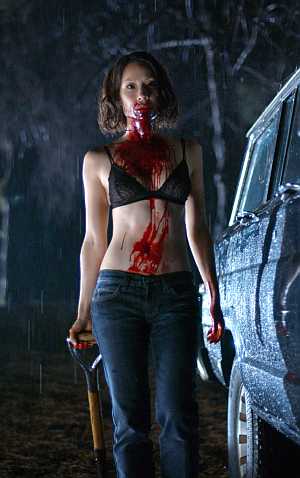 The main obstacle to this even reaching average is probably a first-half structure that is, for no readily apparent season, entirely fractured. Scenes appear entirely out of order, with no explanation: why is our heroine now waking up in a morgue? And the problem is, what the film has to offer is so pedestrian, you can’t be bothered to start putting the pieces together. Liu plays Sadie Blake, a journalist investigating the shady underground side of goth culture, who ends up finding a clan of vampires are on top of the food chain, just before becoming one of their victims. However, instead of taking her undeath lying down, she vows revenge and, accompanied by a rogue cop (Chiklis, you’ll not be surprised to learn), begins working her way up said food-chain.
The main obstacle to this even reaching average is probably a first-half structure that is, for no readily apparent season, entirely fractured. Scenes appear entirely out of order, with no explanation: why is our heroine now waking up in a morgue? And the problem is, what the film has to offer is so pedestrian, you can’t be bothered to start putting the pieces together. Liu plays Sadie Blake, a journalist investigating the shady underground side of goth culture, who ends up finding a clan of vampires are on top of the food chain, just before becoming one of their victims. However, instead of taking her undeath lying down, she vows revenge and, accompanied by a rogue cop (Chiklis, you’ll not be surprised to learn), begins working her way up said food-chain.




 Antonio (Ugalde) and Emilio (Cardona) meet the gorgeous Rosario (Martinez) at a nightclub in Medellin, Columbia, and both form a relationship with her – Emilio, a physical one; Antonio, a platonic but perhaps more deeply felt attachment. While information on Rosario is limited, not least from herself, they soon discover that she has a dark past (Tijeras isn’t her surname, it’s Spanish for “scissors”. Let’s leave it at that, shall we?) and a dark present (among the many rumour swirling around is that she has killed 200 or more, in her role as a hitwoman for the local drug cartels). Nor is the forecast for her future sunshine and rainbows, since the first scene has Antonio carrying a badly shot-up Rosario into a local hospital, with the rest of the film told in a series of flashbacks.
Antonio (Ugalde) and Emilio (Cardona) meet the gorgeous Rosario (Martinez) at a nightclub in Medellin, Columbia, and both form a relationship with her – Emilio, a physical one; Antonio, a platonic but perhaps more deeply felt attachment. While information on Rosario is limited, not least from herself, they soon discover that she has a dark past (Tijeras isn’t her surname, it’s Spanish for “scissors”. Let’s leave it at that, shall we?) and a dark present (among the many rumour swirling around is that she has killed 200 or more, in her role as a hitwoman for the local drug cartels). Nor is the forecast for her future sunshine and rainbows, since the first scene has Antonio carrying a badly shot-up Rosario into a local hospital, with the rest of the film told in a series of flashbacks. ★★★
★★★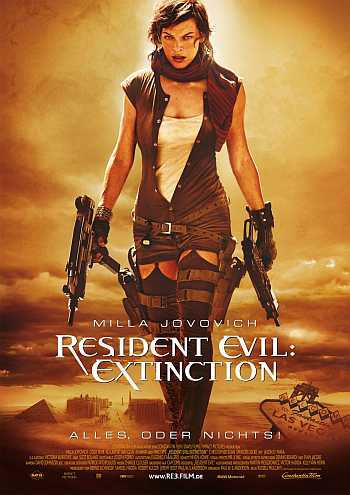 Has it really been three years since the last installment? Guess so. Therefore, about time for the most durable of the video-game to movie franchises, to pop up with another entry. Things continue to go from bad to worse as far as Planet Earth is concerned, with the T-virus, which spread from the complex to Raccoon City last time, now infecting the entire world. A few survivors roam the wastelands, such as in a convoy led by Claire Redfield (Larter), unable to stay in one place too long, because the zombies will locate them. Meanwhile, Dr. Isaacs (Glen) is working on reversing the virus, or at least making the zombies docile – though his approach to scientific teamwork leaves a little to be desired, shall we say. He also has a pit where he disposes of his raw material, an aspect that reminded me of the original Aeon Flux short films.
Has it really been three years since the last installment? Guess so. Therefore, about time for the most durable of the video-game to movie franchises, to pop up with another entry. Things continue to go from bad to worse as far as Planet Earth is concerned, with the T-virus, which spread from the complex to Raccoon City last time, now infecting the entire world. A few survivors roam the wastelands, such as in a convoy led by Claire Redfield (Larter), unable to stay in one place too long, because the zombies will locate them. Meanwhile, Dr. Isaacs (Glen) is working on reversing the virus, or at least making the zombies docile – though his approach to scientific teamwork leaves a little to be desired, shall we say. He also has a pit where he disposes of his raw material, an aspect that reminded me of the original Aeon Flux short films.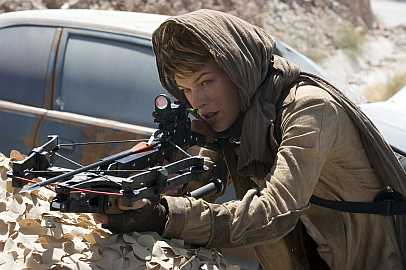 The main problem, I feel, is that giving Alice mental powers detracts from the physical side of action, which has always been a major part of this series’s appeal: watching Jovovich kick zombie butt. The Las Vegas battle is unquestionably the highlight of the film as far as that goes, with Alice adopting a no-nonsense, slice-and-dice approach, that’s a gleeful joy to watch. After it, however, things go somewhat wonky: the entire Redfield subplot is airily waved away, and then there’s the inevitable boss level fight – this time against the Tyrant [if you’ve played the games, you probably know what that is, which puts you one-up on me], a somewhat rubbery, tenticular beast that is not among Patrick Tatopoulos’s best work.
The main problem, I feel, is that giving Alice mental powers detracts from the physical side of action, which has always been a major part of this series’s appeal: watching Jovovich kick zombie butt. The Las Vegas battle is unquestionably the highlight of the film as far as that goes, with Alice adopting a no-nonsense, slice-and-dice approach, that’s a gleeful joy to watch. After it, however, things go somewhat wonky: the entire Redfield subplot is airily waved away, and then there’s the inevitable boss level fight – this time against the Tyrant [if you’ve played the games, you probably know what that is, which puts you one-up on me], a somewhat rubbery, tenticular beast that is not among Patrick Tatopoulos’s best work. Things do perk up at the very end. As in the first two films, there’s a grand final shot, which leaves you eagerly anticipating the next part – in this case, presumably called Resident Evil: Globapocarnarmagediediedie. Certainly, I wouldn’t be
Things do perk up at the very end. As in the first two films, there’s a grand final shot, which leaves you eagerly anticipating the next part – in this case, presumably called Resident Evil: Globapocarnarmagediediedie. Certainly, I wouldn’t be 










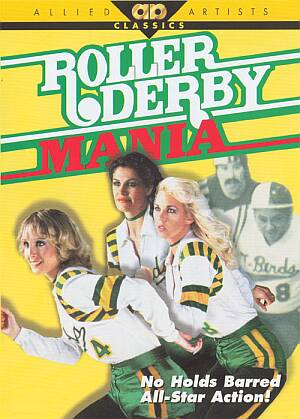 This dates back to 1986, which is a little odd, as the sport was pretty much in one of its down-turns at the time – the excesses of RollerGames were still a couple of years away at that point. This isn’t probably the best place for a novice to start, as there’s no explanation at all about the sport, since it assumes you know what’s going on, how bouts are staged, scored and what the rules are . There’s a little about the history (including a cute song from the 1940’s), but it’s mostly action featuring the Los Angeles T-Birds.
This dates back to 1986, which is a little odd, as the sport was pretty much in one of its down-turns at the time – the excesses of RollerGames were still a couple of years away at that point. This isn’t probably the best place for a novice to start, as there’s no explanation at all about the sport, since it assumes you know what’s going on, how bouts are staged, scored and what the rules are . There’s a little about the history (including a cute song from the 1940’s), but it’s mostly action featuring the Los Angeles T-Birds. ★★★★
★★★★
 This is our first ever video game review on gwg.org, and just so you know I’m not making any of this up, here’s a synopsis of the storyline for this one, taken from
This is our first ever video game review on gwg.org, and just so you know I’m not making any of this up, here’s a synopsis of the storyline for this one, taken from  It’s kinda hard to decide whether this is feminist or sexist. There’s no doubt that these are strong, independent women who can kick ass with the best of them. Yet they also wear outfits which would prove structurally unfeasible in real life, and you could say the same thing about physical attributes resembling a multiple Zeppelin pile-up. Then there’s “mud mode” (left), which is exactly what it sounds like. Of course, this cheesecake aspect is far from unheard of: Dead or Alive: Beach Volleyball took the female characters from the beat-em-up game and put them in swimsuits to play volleyball against each other. Yet, its roleplaying aspects made that one a favourite with our teenage
It’s kinda hard to decide whether this is feminist or sexist. There’s no doubt that these are strong, independent women who can kick ass with the best of them. Yet they also wear outfits which would prove structurally unfeasible in real life, and you could say the same thing about physical attributes resembling a multiple Zeppelin pile-up. Then there’s “mud mode” (left), which is exactly what it sounds like. Of course, this cheesecake aspect is far from unheard of: Dead or Alive: Beach Volleyball took the female characters from the beat-em-up game and put them in swimsuits to play volleyball against each other. Yet, its roleplaying aspects made that one a favourite with our teenage 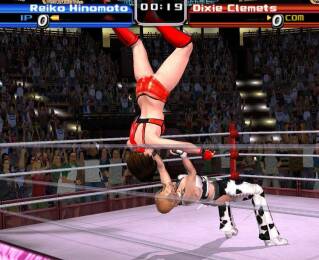 My playing-style is your average button-masher, but it took me only an hour or so to beat the game with my first character – there are ten to choose from at the beginning, and playing through story mode in each one unlocks their alter-ego. Play through all 20, and you can be the bosses too, but be warned: the voice acting is horrible, and the storylines positively wince-inducing. In addition, you can play straightforward exhibition matches, and carrying out certain tasks, known as “vows” e.g. winning inside three minutes, can cause characters to switch from good to bad versions too. A problem here seems to be that you can’t have both alignments active simultaneously, so you’re not able to have Reiko Hinomoto (nice) take on Rowdy Reiko (naughty).
My playing-style is your average button-masher, but it took me only an hour or so to beat the game with my first character – there are ten to choose from at the beginning, and playing through story mode in each one unlocks their alter-ego. Play through all 20, and you can be the bosses too, but be warned: the voice acting is horrible, and the storylines positively wince-inducing. In addition, you can play straightforward exhibition matches, and carrying out certain tasks, known as “vows” e.g. winning inside three minutes, can cause characters to switch from good to bad versions too. A problem here seems to be that you can’t have both alignments active simultaneously, so you’re not able to have Reiko Hinomoto (nice) take on Rowdy Reiko (naughty). The graphics kick ass. An awful lot of polygons (I believe around 10,000!) go into each character, with detailed hair, costumes, tattoos, backgrounds and other refinements that look good even on the biggest TV set. However, when the wrestlers run, it sometimes doesn’t work at all. The music is pretty lame J-Pop, so you’ll probably rapidly find yourself turning off the entrance videos too. On the down side, as well as practice mode, we could have used tag matches, survival mode, create-a-character, a bigger range of locations… The options present here are pretty sparse, though in gaming I suppose it’s usually better not to be a jack-of-all-trades.
The graphics kick ass. An awful lot of polygons (I believe around 10,000!) go into each character, with detailed hair, costumes, tattoos, backgrounds and other refinements that look good even on the biggest TV set. However, when the wrestlers run, it sometimes doesn’t work at all. The music is pretty lame J-Pop, so you’ll probably rapidly find yourself turning off the entrance videos too. On the down side, as well as practice mode, we could have used tag matches, survival mode, create-a-character, a bigger range of locations… The options present here are pretty sparse, though in gaming I suppose it’s usually better not to be a jack-of-all-trades. ★★★★
★★★★
 The tactic here was simple and clear. Keep all the good stuff from the original, e.g. Milla Jovovich, zombie dobermans, and throw a few new elements in, this time including some stuff which, unlike Jovovich’s character, Alice, actually has a significant connection to the game. Hence, you get Jill Valentine (Guillory), a special forces chick who, in most other movies, would be the heroine, but is here largely to show you how Alice v2.0 has been improved beyond human. It’s reminiscent of how Ripley, by Alien Resurrection, had partly been transformed into what she was fighting, and Alice is now faster, stronger and cooler than she was last time – which is something of an achievement in itself.
The tactic here was simple and clear. Keep all the good stuff from the original, e.g. Milla Jovovich, zombie dobermans, and throw a few new elements in, this time including some stuff which, unlike Jovovich’s character, Alice, actually has a significant connection to the game. Hence, you get Jill Valentine (Guillory), a special forces chick who, in most other movies, would be the heroine, but is here largely to show you how Alice v2.0 has been improved beyond human. It’s reminiscent of how Ripley, by Alien Resurrection, had partly been transformed into what she was fighting, and Alice is now faster, stronger and cooler than she was last time – which is something of an achievement in itself. Or at least, mostly solidly – let’s get the criticism out of the way first. Witt wants to stick the camera right in there, when what we want to do is fully appreciate the grace and athleticism of the heroines, not suffer from motion sickness. Also: hello, “R”-rating? Presumably this was for the language, topless undead hookers, and Milla’s scarily-large nipples (Chris pointed out they’re almost larger than her breasts), because it certainly wasn’t for the gore. These monsters were almost bloodless, even when shot through the head or exploded by hand-grenade – the latter would seem dangerous when you’re dealing with a highly-infectious, fluid-borne disease, but I’m quibbling here.
Or at least, mostly solidly – let’s get the criticism out of the way first. Witt wants to stick the camera right in there, when what we want to do is fully appreciate the grace and athleticism of the heroines, not suffer from motion sickness. Also: hello, “R”-rating? Presumably this was for the language, topless undead hookers, and Milla’s scarily-large nipples (Chris pointed out they’re almost larger than her breasts), because it certainly wasn’t for the gore. These monsters were almost bloodless, even when shot through the head or exploded by hand-grenade – the latter would seem dangerous when you’re dealing with a highly-infectious, fluid-borne disease, but I’m quibbling here. As mentioned, the undead attack canines are also back, and just as bad as before; this time, it’s mostly Valentine who has to deal with them, at least until the end, when Alice effortlessly one-ups her rival yet again. We briefly muttered “catfight!” under our breath, and it’d certainly have been fun to see Jill and Alice go toe-to-toe, but the outcome of that would be so predictable – Alice would win, without even breaking sweat – that its omission is understandable. The supporting characters do their job adequately; Mike Epps is the comic relief, something not really present in the first film, and manages the tricky task of doing the job without becoming annoying. Oded Fehr is somewhat irrelevant as a soldier also after the scientist’s daughter, while Sandrine Holt, playing journalist Terri Morales, is understandably overshadowed by Jill and Alice. On the Umbrella side…blah evil corporate drone, blah misunderstood scientist blah, blah. We don’t care – and nor should we.
As mentioned, the undead attack canines are also back, and just as bad as before; this time, it’s mostly Valentine who has to deal with them, at least until the end, when Alice effortlessly one-ups her rival yet again. We briefly muttered “catfight!” under our breath, and it’d certainly have been fun to see Jill and Alice go toe-to-toe, but the outcome of that would be so predictable – Alice would win, without even breaking sweat – that its omission is understandable. The supporting characters do their job adequately; Mike Epps is the comic relief, something not really present in the first film, and manages the tricky task of doing the job without becoming annoying. Oded Fehr is somewhat irrelevant as a soldier also after the scientist’s daughter, while Sandrine Holt, playing journalist Terri Morales, is understandably overshadowed by Jill and Alice. On the Umbrella side…blah evil corporate drone, blah misunderstood scientist blah, blah. We don’t care – and nor should we.



































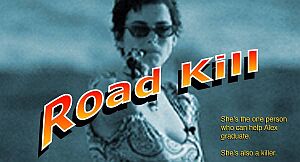 Advertised with the fetching slogan, “Guns don’t kill people – she does”, this is a film about a film, specifically the graduation documentary being made by Alex (Palladino), who has the good fortune to live opposite hitwoman, Blue (Rubin). She just happens to be going on her final job, and agrees to let him and sound-man Lars (Jayne) come along. On the way, however, things come out of the closet about Blue’s background, and Alex finds himself crossing the line between documentarian and instigator.
Advertised with the fetching slogan, “Guns don’t kill people – she does”, this is a film about a film, specifically the graduation documentary being made by Alex (Palladino), who has the good fortune to live opposite hitwoman, Blue (Rubin). She just happens to be going on her final job, and agrees to let him and sound-man Lars (Jayne) come along. On the way, however, things come out of the closet about Blue’s background, and Alex finds himself crossing the line between documentarian and instigator. Rubin, given the chance, does a good job, though it’s only in the final confrontational scene that we get to see what she is really capable of doing. Until then, the job of assassin seems little more interesting than that of a travelling salesman – she drives cross-country, pop-pop, and drives home again. It’s all rather too prosaic, making it hard to see why Alex (or, indeed, the viewer), would want to get so involved. It certainly isn’t the glamour or the excitement.
Rubin, given the chance, does a good job, though it’s only in the final confrontational scene that we get to see what she is really capable of doing. Until then, the job of assassin seems little more interesting than that of a travelling salesman – she drives cross-country, pop-pop, and drives home again. It’s all rather too prosaic, making it hard to see why Alex (or, indeed, the viewer), would want to get so involved. It certainly isn’t the glamour or the excitement.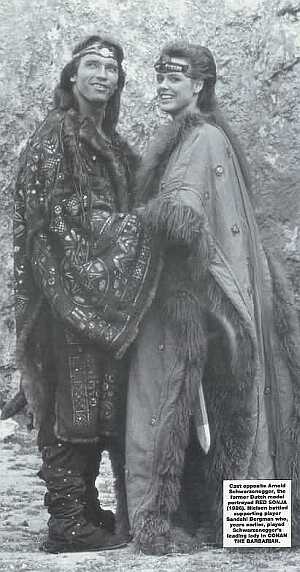 No, really. The milliner on this production deserves an Oscar, simply for providing the most amazing range of headgear I’ve ever seen. Everyone seems to have a different selection of pointy things to choose from; this civilization may have limited technology, but it’s clearly not short of hat-shops.
No, really. The milliner on this production deserves an Oscar, simply for providing the most amazing range of headgear I’ve ever seen. Everyone seems to have a different selection of pointy things to choose from; this civilization may have limited technology, but it’s clearly not short of hat-shops.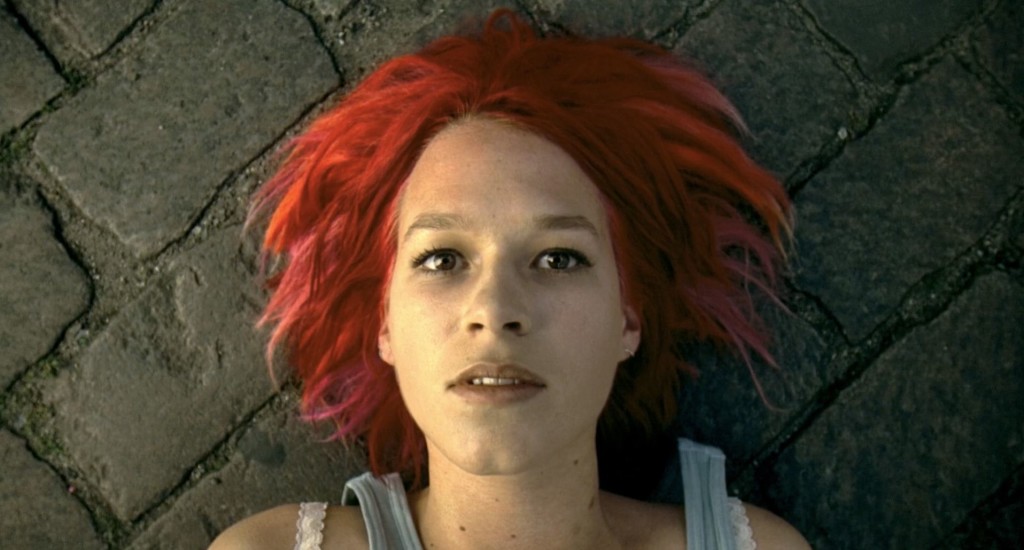


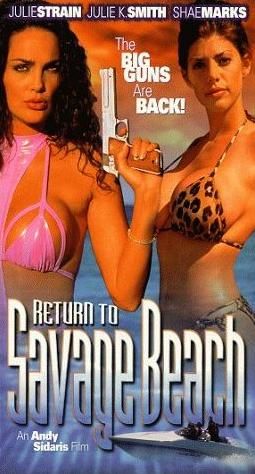 This was Sidaris’s last film, and after the disappointment of Warrior, it’s nice to see him return to a more straightforward approach, with little of the post-modernity attempted there. It is largely a sequel to Savage Beach, with a raid on the LETHAL offices puzzling Willow (Strain) and her agents, because the only thing accessed was the files on that case, which have long been closed. However, it turns out the villain there, Rodrigo (Obregon) did not die in a fiery, explosive-tipped crossbow bolt explosion as thought, and now sports a nifty mask, apparently lifted from a production of Phantom of the Opera. He sends his blonde minion in her submarine(!), along with his ninjas(!!), back to the island to claim a priceless Golden Buddha buried there, and it’s up to Cobra (Smith), Tiger (Marks) and their himbo colleagues, to stop him.
This was Sidaris’s last film, and after the disappointment of Warrior, it’s nice to see him return to a more straightforward approach, with little of the post-modernity attempted there. It is largely a sequel to Savage Beach, with a raid on the LETHAL offices puzzling Willow (Strain) and her agents, because the only thing accessed was the files on that case, which have long been closed. However, it turns out the villain there, Rodrigo (Obregon) did not die in a fiery, explosive-tipped crossbow bolt explosion as thought, and now sports a nifty mask, apparently lifted from a production of Phantom of the Opera. He sends his blonde minion in her submarine(!), along with his ninjas(!!), back to the island to claim a priceless Golden Buddha buried there, and it’s up to Cobra (Smith), Tiger (Marks) and their himbo colleagues, to stop him.